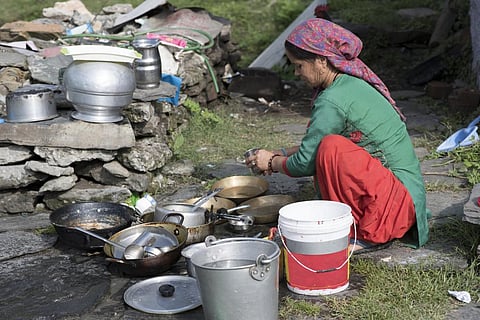Global South water-sensitive cities: Focus should be inequity in access, functionality and reusability
The Global South water-sensitive cities framework developed by New Delhi-based Centre for Science and Environment aimed to define the context and priorities of water-sensitive cities, framing them in the context of the Global South cities.
Cities of Global North countries are planned cities, mostly in a temperate climate (except Australia and some countries in the middle east). The basic infrastructure of water supply, sewerage and drainage already exists and the polluting industry is absent.
The water-sensitive cities discourse has emerged as an overarching aim of making their planned cities more liveable and attractive for residential and commercial growth. The discourse of blue-green infrastructure opposing grey infrastructure arises from this.
Breaking up of grey infrastructure, like roads built over covered drainage channels, large flyovers and highways, etc, gives more visibility to the green-blue narrative.
Water-sensitive urban design, therefore, emerged as a “design” priority for cities that are already well-planned with strict restrictions on density and land use. The word “planning” was missing and added later on.
The reverse is the case of cities of the Global South, which have large informal settlements. Without “urban planning”, one can expect only modest must “design” interventions to make cities water sensitive.
Cities of Global South countries cannot copy-paste frameworks and solutions emerging from the Global North. These cities are not homogenous in terms of their size. What is common, however, is the large and growing inequity in urban land use, the large unplanned and informal settlements and their poor living conditions.
The priorities of our growing cities remain more grey infrastructure to fill the increasing demand for water supply and waste/used water management, as well as stormwater drainage to ensure that our wastewater treatment infrastructure is functional.
Creating blue-green infrastructure is also important for cities of the Global South. This requires a major change in private ownership of urban land holding to create more space for both basic grey and blue-green infrastructure creation.
Unfortunately, the reverse is happening in our cities, as more and more publicly owned land is either encroached upon for private use or a change in land use (from open spaces to commercial, residential and recreational use) is authorised by formal Master Planning process, often under the influence of big real estate builders and politicians lobby.
This is not to deny the need to focus on blue-green infrastructure in Global South countries. It is only to drive the point that we need to define our own priorities for both grey and blue-green infrastructure creation. Not use the narratives emerging from Global North countries to “green-blue wash” our work.
Addressing climate change-induced flooding and water stress in Europe and Australia is about coping with sea rise and flash floods.
Climate change in the Global South cities context, especially the large cities of South Asia, is not only about our short and increasingly intensive monsoon rainfall cycle impacted by climate change. It is also about the large built-up urban land area, creating in-situ flooding threats, even in normal rainfall periods.
In intense rainfall periods, as we saw in Bengaluru and Lucknow in 2022, the city become river channels. Hence for cities of the Global South, addressing climate change-induced water scarcity and flooding is about conserving water and enhancing drainage norms of grey infrastructure.
The Global South water-sensitive cities framework must define equity and justice as the core of any grey and blue-green infrastructure planning and implementation.
Who will undertake blue-green infrastructure and who cannot? Who will benefit from any blue-green infrastructure and who may end up being denied its use? These are important considerations.
Cities of the Global South are expanding cities. Their growing demand for water and their increasing wastewater footprint is a problem for the rural hinterland in the Global South.
Hence the Global South water-sensitive cities framework needs to look beyond making the city more liveable(this is possible by dumping all the waste outside the city limits).
A copy-paste, normative and techno-managerial framing of the discourse for water-sensitive cities in the Global South risks sub-optimal outcomes. A normative blue-green infrastructure discourse may end up with beautification outcomes.
This results in a status quo of inequity in access to enhanced benefits from ad-hoc interventions of water conservation and floodproofing, even displacing the most vulnerable urban poor while protecting the rich dwellers of apartments built by real estate builders on encroached lakes.
Four elements constitute the priorities or pillars of framing Global South water-sensitive cities.
- Inadequacy of grey infrastructure in dense informal settlements
- Inadequacy of integrated centralised and decentralised sanitation and wastewater treatment systems for the city as a whole
- Poor functionality of existing infrastructure of water and wastewater treatment and its reuse
- the growing climate change-induced water stress, as well as larger grey infrastructure for drainage of flash flooding
All measures of blue-green infrastructure are indeed required and urgent. We need to conserve more rainfall and recharge groundwater and we need more green cover.
However, these measures will not mean much if we fail to address the inequity of water and wastewater management and the functionality and access of grey infrastructure.
These four pillars constitute the “index” of the CSE water-sensitive cities framework for the Global South, on which all blue-green interventions of water-sensitive cities should be assessed.
If the inequity in access, functionality and reusability do not improve, then all blue-green interventions may be worthless in making our cities of the Global South truly water sensitive.


